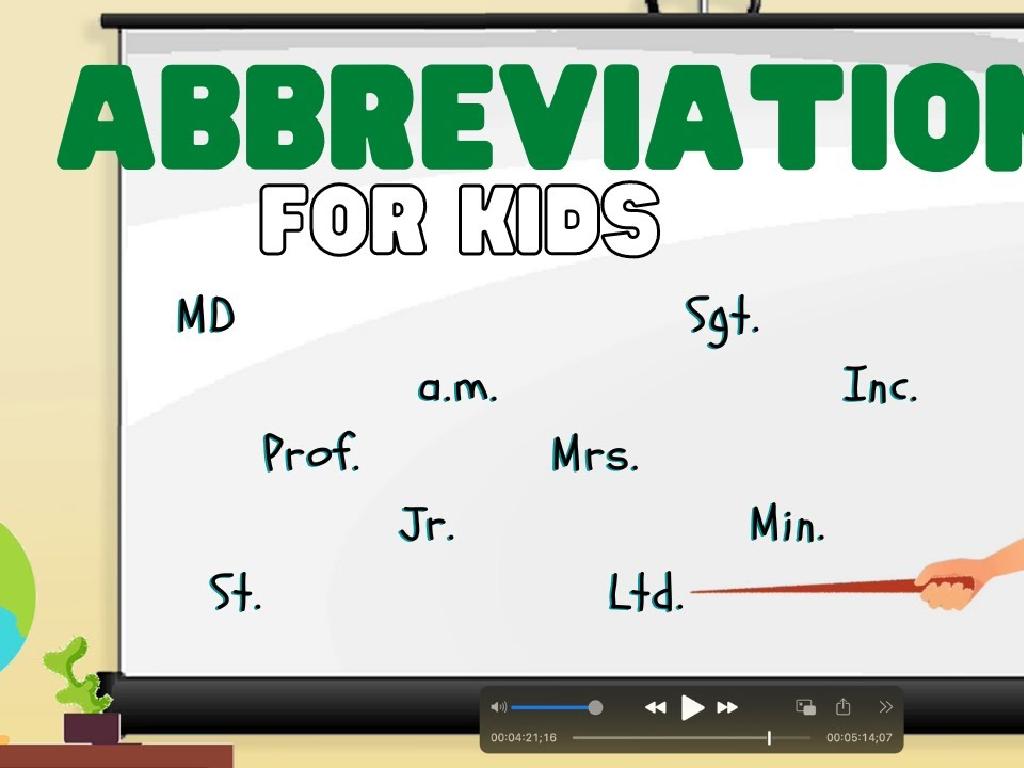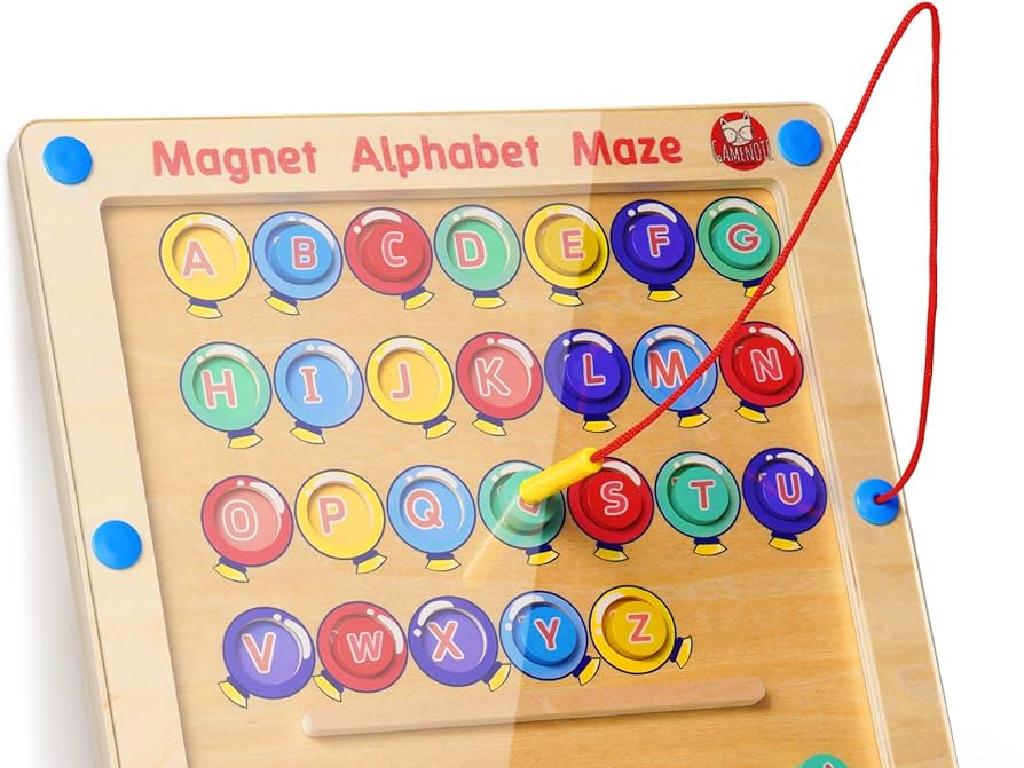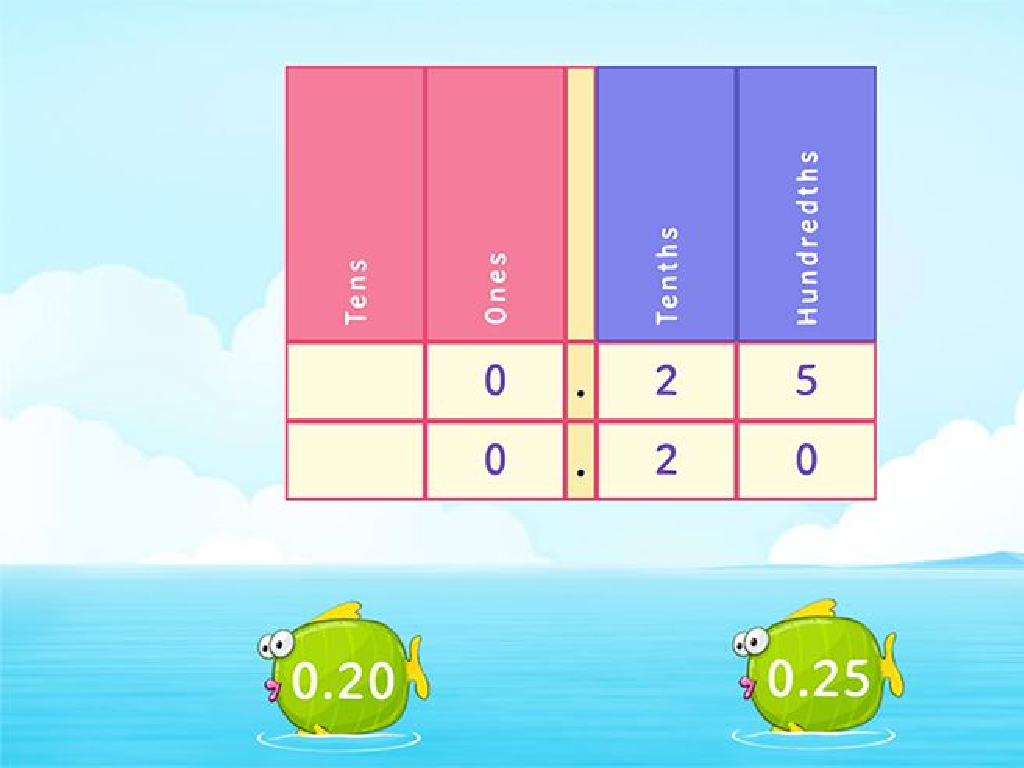Subtract By Counting On - Up To 10
Subject: Math
Grade: First grade
Topic: Subtraction Strategies Up To 10
Please LOG IN to download the presentation. Access is available to registered users only.
View More Content
Welcome to Subtraction!
– Subtraction means taking away
– Imagine sharing cookies
– If you have 5 cookies and give away 2, how many are left?
– Learn to subtract up to 10
– Count on to subtract
– Instead of taking away, we’ll count up from the smaller number to the bigger number
|
This slide introduces the concept of subtraction to first graders by relating it to a familiar activity: sharing cookies. Explain that subtraction is the process of finding out how many things are left after some are taken away. Use real-life examples that are relatable to the students, such as sharing cookies with friends, to illustrate the concept. Demonstrate how to subtract by counting on from the smaller number up to the larger number, using numbers up to 10. For example, if we have 5 and subtract 2, we can count 3, 4, 5 to find out that 3 is left. Encourage students to use their fingers or objects to practice this ‘counting on’ method. Prepare to engage the class with hands-on activities where they can practice this skill with various examples.
Understanding Subtraction: Counting On
– Subtraction means taking away
– Imagine removing items from a group
– It shows how many are left
– After taking some away, count what’s left
– Example with apples
– Start with 5 apples, eat 2, count remaining
– Practice counting on
|
This slide introduces the concept of subtraction to first graders by relating it to taking away items from a group and finding out what remains. Use tangible examples like apples, which children can easily visualize. Explain that subtraction helps us figure out the number of items left after some are taken away. For the apple example, have the students imagine having 5 apples and eating 2, then counting the remaining apples. Encourage the students to use their fingers to ‘count on’ from the number subtracted to reinforce the concept. This method helps build a foundational understanding of subtraction as a means to determine the remaining quantity in a set.
Subtraction by Counting Back
– Use fingers or a number line
– Example: 10 fingers, put 3 down
– If you start with 10 and put 3 fingers down, count the remaining fingers.
– Counting back shows what’s left
– This method helps us subtract by seeing the remaining fingers or numbers.
– Practice with different numbers
– Try subtracting other numbers like 10 – 2 or 10 – 4 using your fingers.
|
This slide introduces the concept of subtraction by counting back, a fundamental strategy for first graders. Start by explaining that they can use their fingers or a number line to subtract. Demonstrate with an example: if they have 10 fingers up and put 3 down, they can count the remaining fingers to find the answer. Emphasize that counting back helps us understand subtraction visually and practically. Encourage students to practice with different numbers up to 10, using their fingers or a number line. This hands-on activity will help solidify their understanding of subtraction as ‘taking away’.
Counting On: A Subtraction Strategy
– Start with the smaller number
– Count up to the larger number
– Practice counting: 3 to 7
– Begin at 3, then say: 4, 5, 6, 7
– How many numbers did we count?
– We counted 4 numbers to reach 7 from 3
|
This slide introduces the ‘Counting On’ strategy for subtraction, which can be easier for young students than traditional methods. Start by explaining that instead of taking away, we can count up from the smaller number to the larger number. Use the example provided to count from 3 to 7 with the class, ensuring they understand that each count represents a single unit being added. Ask the students how many numbers they counted to reinforce the concept. This method helps students visualize subtraction as a form of counting, which can be more intuitive at this stage of their mathematical development.
Using Objects to Learn Subtraction
– Use blocks to subtract
– Start with 8 blocks
– Imagine having 8 toy blocks in front of you
– Take away 5 blocks
– If you give away 5 to a friend, how many do you have left?
– Count the remaining blocks
– After giving away 5, count what’s left to find the answer
|
This slide introduces a hands-on activity for first graders to understand subtraction by using tangible objects such as blocks or toys. Start by explaining that subtraction means taking away some from a total number. Show them 8 blocks, then physically remove 5, and ask the students to count the remaining blocks. This visual and physical representation helps them grasp the concept of ‘taking away’ in a concrete manner. For the activity, each student or group should have a set of blocks to practice with. Encourage them to try subtracting different numbers of blocks and counting what’s left to reinforce the concept.
Subtracting with Stories
– Subtraction can be fun with stories
– Imagine 6 birds, 2 fly away
– Start with 6 birds on a tree
– How many birds are left?
– If 2 birds fly away, count down to find out
– Stories show subtraction in life
– Relate subtraction to everyday situations
|
This slide introduces the concept of subtraction through storytelling, which makes the learning process engaging for first graders. Start by explaining that subtraction means taking away from a group. Use the story of birds on a tree to illustrate this: if we have 6 birds and 2 fly away, we subtract 2 from 6 to find out how many are left. Encourage the students to visualize the birds leaving and count the remaining ones. This helps them understand subtraction as a part of everyday experiences. Ask the students to come up with their own stories and share them with the class to reinforce the concept.
Let’s Practice Together: Subtracting by Counting On
– Try subtracting by counting on
– We’ll solve problems as a group
– Use fingers, objects, or a number line
– Count up from the smaller number to the larger number to find the difference
– Remember, counting on makes it fun!
|
This slide is designed for an interactive class activity where students will practice the subtraction strategy of counting on. Encourage the students to actively participate by trying to subtract numbers up to 10 using counting on. Demonstrate the method on the board and invite students to come up and solve problems as well. Remind them that they can use their fingers, objects like counters, or a number line to assist them in visualizing the subtraction process. Emphasize that counting on is a helpful strategy that can make subtraction easier and more enjoyable. Prepare a set of subtraction problems for the students to solve and consider pairing them up for peer learning. Offer praise and guidance as they work through the problems.
Class Activity: Subtraction Bingo
– Let’s play Subtraction Bingo!
– Solve subtraction problems up to 10
– Use ‘counting on’ to find the answer
– Cover the answer on your Bingo card
– Shout ‘Bingo!’ for a full row
– We’ll check if your answers are correct together
|
This interactive game is designed to help first graders practice their subtraction skills in a fun and engaging way. Each student will receive a Bingo card with a variety of numbers up to 10. As the teacher calls out subtraction problems, students will use the ‘counting on’ method to find the correct answers and cover them on their cards. The goal is to cover a full row of answers to win the game. This activity encourages quick thinking and reinforces the concept of subtraction by counting on. Be prepared with a list of subtraction problems and ensure that each Bingo card has a different configuration of answers. Have small prizes or stickers ready for the winners to celebrate their success. This activity not only solidifies mathematical understanding but also promotes a positive and collaborative classroom environment.






